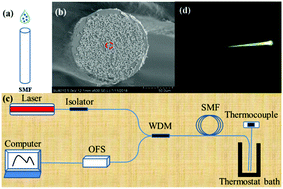Highly reliable all-fiber temperature sensor based on the fluorescence intensity ratio (FIR) technique in Er3+/Yb3+ co-doped NaYF4 phosphors†
Abstract
Accurate and remote temperature measurements in harsh environments are of great importance. The FIR technique is self-referenced and regarded as a promising method to improve the temperature accuracy and simplify the experimental devices. Herein, a point all-fiber temperature sensor based on the FIR technique has been developed. Er3+/Yb3+ co-doped NaYF4 phosphors (NPs) were used to fabricate a temperature sensing probe combined with silica fiber. Highly crystalline and pure hexagonal NPs were synthesized by a hydrothermal method. Intense green up-conversion luminescence was observed in the prototype sensor at an excitation power of 1 mW. The relationship between FIR value and temperature was investigated at the temperature range of 258–423 K. The maximum relative temperature sensitivity is 1.68% K−1 at 258 K. Preliminary experimental results indicate that the absolute error is ±1 K with a temperature uncertainty σ of 0.187 K and relative standard deviation of 0.133%, suggesting the high accuracy and reliability of the proposed all-fiber temperature sensor.



 Please wait while we load your content...
Please wait while we load your content...